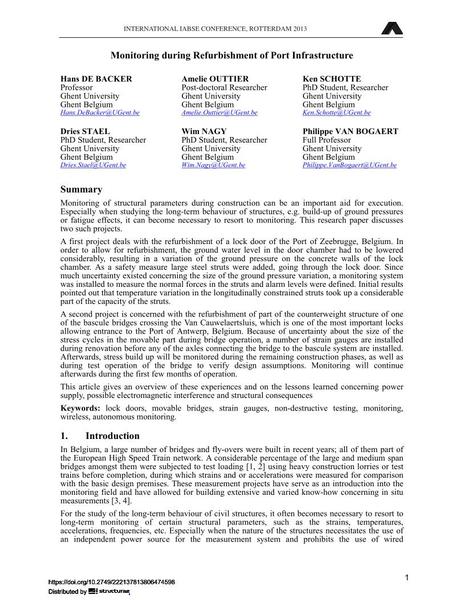Monitoring during Refurbishment of Port Infrastructure

|
|
|||||||||||
Détails bibliographiques
| Auteur(s): |
Hans De Backer
Amelie Outtier Ken Schotte Dries Stael Wim Nagy Philippe Van Bogaert |
||||
|---|---|---|---|---|---|
| Médium: | papier de conférence | ||||
| Langue(s): | anglais | ||||
| Conférence: | IABSE Conference: Assessment, Upgrading and Refurbishment of Infrastructures, Rotterdam, The Netherlands, 6-8 May 2013 | ||||
| Publié dans: | IABSE Conference, Rotterdam, May 2013 | ||||
|
|||||
| Page(s): | 156-157 | ||||
| Nombre total de pages (du PDF): | 8 | ||||
| Année: | 2013 | ||||
| DOI: | 10.2749/222137813806474598 | ||||
| Abstrait: |
Monitoring of structural parameters during construction can be an important aid for execution. Especially when studying the long-term behaviour of structures, e.g. build-up of ground pressures or fatigue effects, it can become necessary to resort to monitoring. This research paper discusses two such projects. A first project deals with the refurbishment of a lock door of the Port of Zeebrugge, Belgium. In order to allow for refurbishment, the ground water level in the door chamber had to be lowered considerably, resulting in a variation of the ground pressure on the concrete walls of the lock chamber. As a safety measure large steel struts were added, going through the lock door. Since much uncertainty existed concerning the size of the ground pressure variation, a monitoring system was installed to measure the normal forces in the struts and alarm levels were defined. Initial results pointed out that temperature variation in the longitudinally constrained struts took up a considerable part of the capacity of the struts. A second project is concerned with the refurbishment of part of the counterweight structure of one of the bascule bridges crossing the Van Cauwelaertsluis, which is one of the most important locks allowing entrance to the Port of Antwerp, Belgium. Because of uncertainty about the size of the stress cycles in the movable part during bridge operation, a number of strain gauges are installed during renovation before any of the axles connecting the bridge to the bascule system are installed. Afterwards, stress build up will be monitored during the remaining construction phases, as well as during test operation of the bridge to verify design assumptions. Monitoring will continue afterwards during the first few months of operation. This article gives an overview of these experiences and on the lessons learned concerning power supply, possible electromagnetic interference and structural consequences |
||||
| Mots-clé: |
pont mobiles
|
||||
